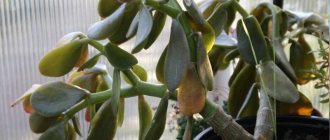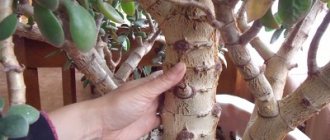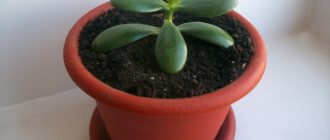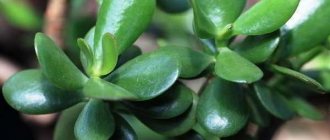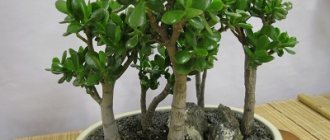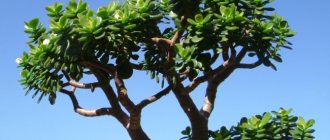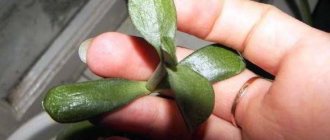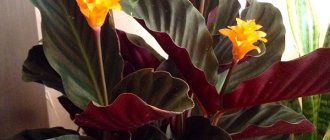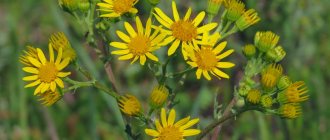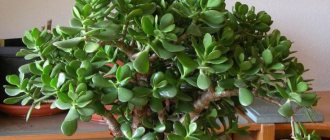International name:
Synonyms:
Characteristics:
| Complexity: |
| Development cycle: |
| Light mode: |
| Watering mode: |
| Temperature: |
| The soil: |
| Key Feature: |
Foliage color
Bud color
Dimensions Flower sizes
Taxonomy:
| Domain: |
| Kingdom: |
| Department: |
| Class: |
| Order: |
| Family: |
| Genus: |
While a warm home environment is great for a gardener, low humidity and reduced light levels make it a challenge for plants. Fortunately, for avid gardeners, there are several other plants that thrive even in harsh conditions . One of these is the well-known Money Tree.
This is a succulent plant that requires very little water in summer, and even less in winter, as it is sensitive to waterlogging. And if you place it in strong sunlight, its leaves may turn a bright red hue. But that’s another story, today we’re looking at what the Money Tree is really called.
Botanical description
Most species of Crassula are perennial plants with pronounced properties of succulents (they can accumulate water and nutrients not only in the roots, but in the trunk and leaves).
The root system of the plant is branched, but covers only the upper layers of the soil. Crassula can do without water for a long time, however, when the soil is sufficiently damp, the root shoots actively consume all the moisture from it, accumulating it in the trunk and leaves of the plants.
The leaves of Crassula are usually oblong, round in shape, located oppositely along the length of the trunk and shoots. They are fleshy and have the ability to retain moisture and microelements in their tissues for a long time (even better than the root or trunk). The leaf color of most varieties is dark green, but light green, pale gray, silver and even red are found. Sometimes the leaves of some varieties have two colors: for example, the border is red, and the main plate is classic green. The size of the plates most often does not exceed 5 cm, but there are species with leaves more than 10 cm in length and 4-5 cm in width.
The Crassula bush can grow up to 3-4 m in height. However, decorative species for indoor cultivation are usually much smaller (15-20 cm).
IMPORTANT! Crassula is known as a poisonous plant. The thing is that in the wild it accumulates a lot of arsenic in its leaves, drawing it from the soil. Indoor varieties are, of course, less harmful, since limited amounts of soil usually contain little arsenic. True, they can also cause allergic reactions or mild poisoning if the juice gets into the mouth or mucous membranes of a person.
The flowers of the plant are less often single, and more often collected in small racemes. In color there are white, yellow, and very rarely red and blue flowers. It is extremely difficult to achieve flowering at home.
Crassula flowering
Diseases
- Dropping leaves, drying out and changing the color from green to yellow - non-compliance with the temperature regime, increased air temperature. This phenomenon often occurs in the cold season, when the flower needs coolness. Also, the reason may be the need for replanting or lack of lighting. Another cause of problems with leaves is excessive soil moisture and frequent watering.
- The tree trunk becomes limp, the leaf blade becomes thinner or darker - a sure sign of the process of rotting of the succulent's root system. This problem occurs due to too frequent watering. Also, the reason may be watering with low temperature water or draft.
- Crassula loses the splendor of its crown, only a small part of the shoots develops and grows, the leaf plate becomes smaller and discolored - a sign of lack of lighting.
Important! Convex “corky” brown spots on the leaves (dropsy) - appears when there is excess moisture in the soil. The plant urgently needs to be replanted by changing the soil. Otherwise, the root system of the money tree will begin to rot, then it will be too late to save the flower.
Plant structure
The money tree is slightly different in its structure from similar plants that are capable of storing large amounts of water in their tissues (succulents).
Roots
Most succulents have a fairly simple and shallow root system. The root is only one of many mechanisms for storing moisture, but not the most important of them.
In this regard, the root system of Crassula consists of a central rhizome, extending to a shallow depth, as well as numerous lateral shoots, most of which lie only 3-4 cm deep in the soil. In a number of species, aerial root shoots can be found.
Due to such underdevelopment of the root system, Crassula has difficulty surviving every transplant. However, this procedure cannot be avoided, because the flower grows quickly.
Another big problem is that the root system is not always able to firmly hold adult Crassulas, as they become large in size. Because of this, you should carefully select a flower pot: it must be strong, large and heavy.
Crassula root system
INTERESTING . The older the money tree, the more woody its main root becomes and the easier it is to survive transplants.
Leaves
Crassula foliage is the most important component of the plant, determining its identity . It is because of them that the flower largely received its more famous name - the money tree. They also serve as the plant’s most important tool for accumulating moisture, as well as useful micro- and macro-compounds in case of prolonged drought.
The leaves of Crassula are fleshy, dense, often small than vice versa. Most varieties cannot boast of large leaves (they reach only about 5 cm in length), but they always grow so tightly together that they form a neat and extremely attractive crown. Their surface is covered with a waxy coating.
The color of the foliage differs on the outside and back. Usually the inside is decorated with pinkish spots, which can even occupy the entire lower plate.
Crassula leaves
Important! An integral part of the beautiful and correct formation of the Crassula crown can be called pinching the shoots. In this case, the classic growth of the flower occurs in the form of a green dense ball.
Flowers
Flowering of Crassula indoors is a rather rare phenomenon, but it also happens. Most varieties bloom with soft white or light yellow flowers. However, the shades may be different, albeit in a few cases.
On the other hand, if flowering is achieved, then almost the entire crown of the plant is dotted with small single flowers (1-2 cm in diameter) or panicles of inflorescences.
One of the characteristic features of Crassula is its persistent, fragrant aromas when flowering.
The plant blooms for the first time late, usually not earlier than 10 years of age . But then flowers can appear every year (and with less frequency, but only if the flower is poorly cared for). The period of appearance of flowers occurs mainly in late autumn or winter, but it also happens in spring. If the plant is cool (not higher than +18С), then flowering can last up to 3 months in a row.
Money tree flowers
Fruit
The fruits of Crassula, in which the seeds ripen, are multileaflets (or collective leaflets). They are formed not in place of flowers and inflorescences, but in special formations on the stem. They are leathery, dry pericarps with seeds that ripen along the seam.
They are practically never found in captivity.
Money tree fruit
Methods of propagation and rooting
When the fat plant is cared for correctly, lightening and shaping pruning is done regularly. The remaining material can be used for vegetative propagation of the money tree.
The method is much simpler than the seed method and allows you to preserve varietal characteristics. In spring or early summer, almost all leaves and cuttings take root. Before or during the dormant period, growth processes slow down and rooting goes poorly.
Vegetative propagation
The branches of the crassula remaining after formation or specially cut ones are dried for at least a day in a warm, well-ventilated room. Then they are placed in water or placed in small individual cups with bottom holes. As a substrate you can use:
- soil for cacti with sand (1:1);
- perlite
The leaves are taken from the middle of the crown of the crassula; they are mature, but not old. It is better to plant them - the plates often rot in water. You can dry it until the turgor is completely lost; experienced cactus growers keep the leaves in the fresh air and warm until they take root.
This is what causes care. During germination of Crassula leaves and cuttings, you must not:
- spray;
- cover with glass or film.
The surface of the substrate should only be carefully watered so that the tender young roots of the fat plant do not dry out. The rest of the care consists of maintaining warmth and moderate lighting. In the shade, in bright sun or at low temperatures, reproduction is likely to fail.
Having produced a new pair of leaves, the cuttings are gradually accustomed to intense lighting and cared for as if they were an adult Crassula. The daughter rosettes formed next to the plate are grown, then separated and planted in individual containers, possibly with the mother leaf.
Propagation by seeds
If the crassula blooms at home, even with good care the seeds do not ripen, you need to buy them. This method of breeding is interesting for breeders; for hobbyists it makes sense if a species or variety cannot be obtained in any other way.
Sowing is done to a depth of 5 mm, kept at high temperature and humidity under glass or film. After the emergence of seedlings, they are accustomed to light and fresh air. Before planting in a permanent pot, they dive twice.
Legends about the flower or why it is called the “Money Tree”
The most common name for Crassula is “money” or also “dollar” tree. This epithet has taken root because the leaves of the plant resemble coins , and they have always been a symbol of wealth and success.
According to another version, the association of a fat wallet, and therefore prosperity, is caused by the trunk of the plant. This flower is thick and dense.
In many ways, all known theories are also supported by the fact that Crassula is a succulent plant, that is, it has the ability to accumulate moisture and nutrients in the roots, leaves, and trunk. That’s why people associate this plant’s ability to collect and preserve what is most important to them with signs about luring money into a wallet with a flower and accumulating wealth.
THIS IS INTERESTING. Particularly superstitious people, even when planting a money tree cutting or replanting a plant, put a coin in the pot for good luck. Sometimes coins are hung on the shoots of the Crassula.
You can also turn to ancient legends. Thus, the money tree was brought back to Ancient China. In this centuries-old culture, the flower was treated with care, they believed that with its energy it brings abundance, wealth, and success.
More interesting beliefs associated with the flower can be found in our article “What signs and superstitions about the “Money tree” (crassula) do you know? Can the plant be kept at home?
Useful tips
- Once a month you need to wipe the leaves from dust. You can wash them gently under a warm shower. You just need to cover the soil with polyethylene or wrap it with cling film. Excess water damages the roots.
- To prevent the plant from tipping over due to its own crown, you need to choose a pot with a wide, stable bottom. Heavy stones or glass balls are placed on the soil, which should not touch the trunk.
- Before planting or replanting, the soil must be disinfected. Even if it's store-bought. And freezing in the freezer or calcining in the oven eliminates many future problems. Additionally, the ground is watered with a hot solution of potassium permanganate. But after this, the plant can be planted no earlier than after 3 days, otherwise there is a risk of burning the roots.
These tips will allow you to grow a beautiful and well-groomed plant. Such a flower will not only be a symbol of wealth, but also a wonderful decoration for your home environment.
Flower varieties
Crassula is very common in home floriculture (according to some versions, it is one of the five most popular flowers). For this reason, dozens of completely different species are grown indoors. Some of them are more popular than others.
Crassula Oval
The most common variety for cultivation outside the wild . The strengths of this Crassula are its amazing unpretentiousness to lighting and watering, a wide variety of colors and shapes of foliage.
Perhaps the most common are leaves with a reddish border, although plants with silvery foliage (in fact, light green with a silvery tint) - even more reminiscent of coins - are gaining more and more followers.
Tree Crassula
Tree varieties are decorative, neat, attractive. These qualities are valued in them first and foremost. Secondly, Tree Crassula is also distinguished by its relative unpretentiousness.
In captivity, this species rarely blooms.
Reasons for lack of flowering
If the plant does not bloom after reaching ten years of age, it means that its conditions are not good enough. Possible reasons:
- Excessive watering. Many inexperienced gardeners water the fat plant too often, not taking into account that it is a succulent. The plant does not need excessive moisture. It is recommended not to water the flower for 10 days, and then “water” it in small doses.
- Frequent transfers. This needs to be done every few years.
- The container is too big. For the plant to bloom, the pot must be tight.
Plant care
Crassula can be safely and quite reasonably called an extremely unpretentious plant , which can be left without watering for quite a long time, fed occasionally, and even placed in a dark place.
On the other hand, with proper care and recreation of ideal temperature conditions, the flower will always look its best, and in some cases it will even bloom, which in itself can be called an amazingly beautiful, but rare phenomenon.
First of all, it is important to remember that Crassula is a guest from warm places. Therefore, it needs a lot of heat and more light (but always diffused). The plant perceives the absence of other conditions relatively calmly.
Temperature and lighting
It is worth knowing that Crassula usually grows in the shade of the jungle or on the slopes of mountains and hills. This means that she does not like direct and constant sunlight. It is better for the plant to be located in shaded areas where there is a minimum of direct sun. It is believed that the ideal location is: balconies (but not on the windowsill), western and eastern windows of the premises.
IMPORTANT POINT. Crassula does not tolerate dust on the leaves, so it is recommended to periodically wipe the plant with a damp cloth or even treat it with a cool shower.
Air temperature is another important thing to monitor. The fat woman prefers a temperature background in the range of +15-20С . But it is important to remember:
- It is advisable not to allow temperatures above +25С for a long time.
- In winter, any temperature drop below +10С is dangerous.
By the way, you can understand that Crassula doesn’t like something in terms of temperature or light by looking at her condition. Under unfavorable conditions, the lower rows of leaves begin to fall off, and the trunk also becomes significantly thinner.
Watering
The main rule for all succulents is to never overwater them! Otherwise, this will lead to a painful appearance of the flower and rotting of the root system.
That is why the soil for Crassula must have 3-5 cm of drainage at the bottom, as well as holes for draining excess moisture.
TIP : It is not recommended to water the money tree with tap water. It is better to use water that has stood for 1-2 days or collected after rains.
Crassula consumes moisture through both roots and leaves. Given this feature of the flower, it must not only be watered well (but do this no more than 1-2 times a week), but also regularly sprayed and wiped with damp wipes or rags.
There are no uniform standards; it all depends on the air temperature and humidity established in the room. It is best to monitor the earthen clod and water the plant every time it dries to a depth of 4-5 cm.
More information in our article “Secrets of watering the “Money tree” (crassula).”
Soil, fertilizing, replanting
Crassulas are not picky about soil quality. They can grow even on very poor sandy soils (this is what happens in the wild). Therefore, for them you can give preference to a mixture of leaf and turf soil, purchased soil for cacti or succulents.
The money tree needs to be replanted about once a year, as it grows. Each next pot should be 5-6 cm larger in diameter than the previous one.
As for fertilizing, Crassula will easily grow without it. On the other hand, it would be a good idea to add mineral mixtures at least once a year during transplantation to reduce the impact of stress from this process.
Read more about growing Crassula in an apartment in our article “How to properly care for the Money Tree (Crassula).”
Can I keep it at home?
Popularly, the fat plant is called the money tree. This is due to the common signs that the plant has acquired:
- Finding a flower at home attracts material well-being;
- If every Wednesday you tell the tree about the expenses made and the amounts earned, it will help increase the latter and implement all plans. In addition, the tree will help avoid unnecessary purchases;
- Lush and thick foliage is a sign of positive energy in the house. In such an environment there will always be money present;
- The fall of a large number of leaves indicates possible material expenses that will be unplanned. Since ancient times, it was believed that the fall of leaves from a fat plant warns of the loss of money;
- For good plant growth and improved financial situation, it is recommended to bury 3 coins in a pot of soil. According to signs, such an action will not allow the wallet to become empty;
Crassula - a symbol of material well-being
- Some people believe that you can achieve material well-being by hanging banknotes on the branches of a money tree. From time to time, banknotes need to be replaced with new ones. Those that were hanging are spent on personal needs; there is no need to store them. This is a kind of launch of the money cycle;
- The tree needs to be replanted as necessary. As a rule, this is done once a year. To prevent material well-being from deteriorating, during this period the plant needs additional care. It should not wither; a new pot is selected that is more spacious than the previous one;
- When one of the household becomes ill, the plant accumulates negativity and begins to wither. After recovery, the representative of the flora regains its original appearance.
There are many folk signs associated with the money tree.
The tree also has other advantages: the presence of bactericidal properties, the absence of allergic compounds in the air. Few people know that Crassula is used in folk medicine. But its dosage should be minimal, since the tree contains poison. The leaves are used to treat skin diseases, rashes, and sore throats. For this, special decoctions are prepared. The juice of the plant helps get rid of bruises and stretch marks.
Important! Crassula leaf is an excellent emergency aid for a bee sting. The leaf is cut and applied to the wound
Caring for a money tree is not an easy task, especially if the plant is withering.
Harm of Crassula
Some people believe that you can’t keep a money tree at home. The main reason is again superstition:
The death of a plant indicates financial collapse
It is worth taking into account that it may be a warning, but not the cause of this event; According to Feng Shui, the tree carries the energy of “yin” (it is a female plant). If most of the plants are succulents, then an excess of female energy is formed
This can lead to deterioration in mood, apathy, reluctance to do anything, and pessimism. It’s not difficult to correct the situation: you need to add a flower with male energy (“yang”).
If the succulent withers, you can expect financial collapse
Important! The female plant has rounded flowers and leaves, and creeping shoots. Male - has spines, pointed leaves and flowers
Of the objective reasons why you can’t keep a money tree at home, there is only one - the leaves contain arsenic. The substance is poisonous, but poisoning can only occur if the leaves are eaten. To avoid unpleasant consequences, the plant should not be accessible to curious animals and small children.
Money tree poison
Wood contains arsenic
Despite the small dosage, special care should be taken if there are children in the house. Poison is dangerous for them in any quantity
An eaten leaf can cause not only diarrhea and vomiting, but also a severe allergic reaction. In some cases, loss of consciousness may occur. Preventing a problem is easier than fixing it. When children appear, the tree is removed out of reach or disposed of.
The money tree will contain poison, it is better to hide it from small children
Conclusion
Crassula or money tree is an unpretentious plant that is perfectly adapted to growing indoors. Perhaps it has many other advantageous points: it is very easy to care for, today there are a large number of varieties that are very different in appearance, and finally, legends are associated with it about attracting success and financial well-being to the owner.
Perhaps all of the above are the main qualities for which so many people want to keep a money tree in their home. In fact, they certainly won’t have any more inconveniences associated with care, but a beautiful flower will appear in the house and with it positive energy to attract wealth (after all, entire generations of Chinese could not have been wrong, right?).
Crassula in nature
It is represented by aquatic plants, creeping herbaceous species and tree-like shrubs. Mostly money trees grow in the tropical latitudes of the African continent.
are over 300 varieties of them in nature . There are herbaceous (these include ampelous and ground-blooded) and bushy forms, similar to branched trees. Some prefer a humid environment.
Take proper care of the monkey tree, and it will definitely bear fruit in the form of financial well-being. Read more about the features of caring for a fat woman at home in this article.
How to prune
The plant needs to be pruned regularly so that the fat plant has a beautiful shape. If the branch has grown very much, it can be cut off. At the same time, at least 4 leaves should remain on it.
Since the flower reaches towards the light, it means that it needs to be periodically turned one way or the other so that the plant is even. It is recommended to pinch the top. This will also help in the formation of a beautiful crown.

